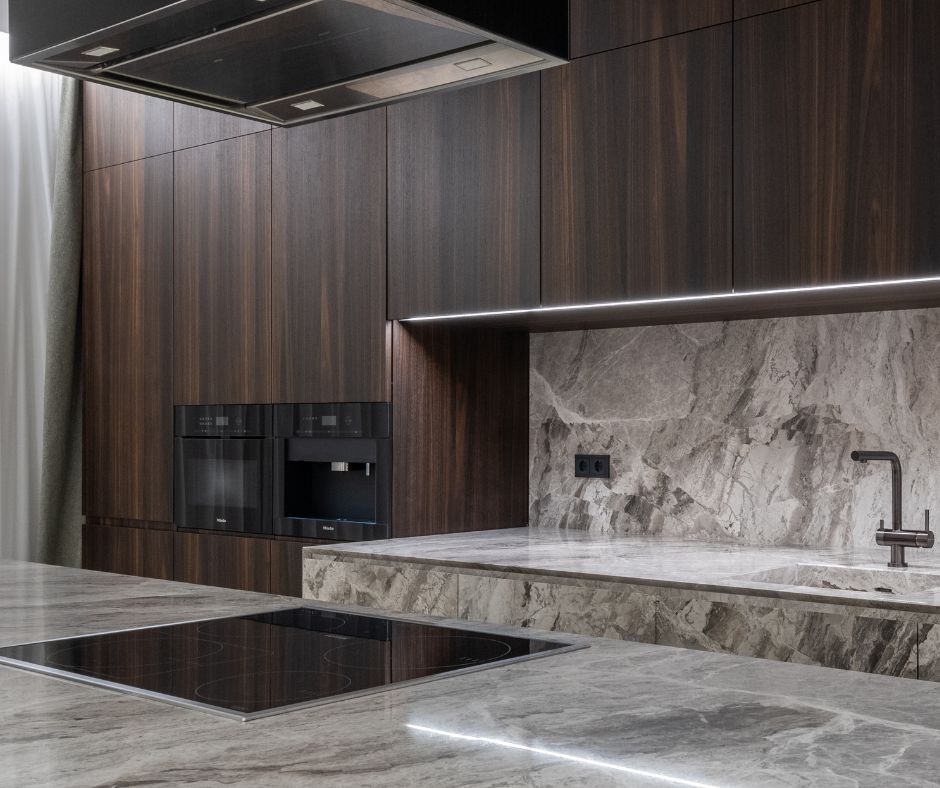Innovative kitchens are at the forefront of new culinary traditions, and induction cooking technology stands out as a remarkable advancement. Although this technology may appear to be a contemporary innovation, its roots can be traced back to the early 20th century. The initial demonstrations in the 1930s amazed spectators with the extraordinary ability to boil water using magnetic energy without any visible heat source. Yet, it is only in recent decades, driven by significant advancements in technology, efficiency, and design, that induction cooktops have firmly established their presence in modern kitchens, revolutionising the way we cook.
In today's culinary landscape, a growing number of home chefs and culinary aficionados are embracing induction cooking due to its remarkable combination of sleek aesthetics, exceptional precision, and unmatched energy efficiency. This innovative cooking method not only accelerates meal preparation but is also transforming the art of home cooking, blending the science of heat management with culinary creativity in every dish prepared on its elegant, polished surface. The right induction cooktop can rival the speed of a microwave, delivering delicious family meals in record time!
Enhancing Culinary Experiences with Precision Cooking Techniques
Unlike traditional gas or electric ranges, induction cooktops directly heat cookware using electromagnetic energy. This cutting-edge approach significantly reduces wasted heat, eliminates the risk of burnt edges, and offers superior control over both low and high temperatures. When you have the ability to manage heat with such precision, your ingredients retain more of their natural moisture, flavour, and nutritional integrity. Whether you're flash-searing proteins, gently simmering sauces, or swiftly blanching vegetables, induction cooking enables you to achieve flawless results effortlessly, steering clear of overcooked meals and nutrient degradation.
Elegant Induction Cooktops: Optimising Kitchen Space and Reducing Stress
In kitchens where every square centimetre is at a premium, induction cooktops excel not only in performance but also in visual appeal. Their flat, smooth surfaces integrate seamlessly into your countertop, presenting a minimalist aesthetic that enhances available space for food preparation, plating, or even enjoying casual meals with family and friends.
Unlike conventional gas hobs, which often feature bulky grates and protruding burners, induction cooktops sit flush with the countertop. While ceramic stovetops may provide a sleeker appearance, they often remain dangerously hot long after cooking has finished, posing a risk.
In stark contrast, induction surfaces cool down rapidly once the cookware is removed. The heat is generated through the magnetic interaction between the cooktop and the cookware rather than by the cooktop itself, meaning the glass surface retains considerably less heat. This characteristic not only makes cleaning safer and easier but also fosters a safer cooking environment, which is especially beneficial for households with children or pets who may be inquisitive about kitchen counters.
The result? A cooler kitchen with cleaner lines and enhanced flexibility—perfect for contemporary cooks who value both aesthetics and functionality.

Comprehensive Guide to Choosing the Right Cookware for Induction Cooking
Transitioning to induction cooking may come with a bittersweet revelation—you may need to part ways with some beloved old pans. As induction technology relies on magnetic energy for heat generation, not all pots and pans will be suitable for this cooking method.
To function effectively on an induction cooktop, cookware must be crafted from ferrous (magnetic) metals, such as cast iron, carbon steel, or magnetic-grade stainless steel. You can easily check compatibility with a simple fridge magnet test: place a magnet on the base of the pan. If it clings firmly, you’re good to go.
When selecting new cookware, choose pans with a heavy, flat base. This design guarantees optimal contact with the cooktop, providing even heat distribution crucial for achieving perfect browning, tender roasts, and crispy edges. Furthermore, high-quality induction cookware is engineered to resist warping over time, ensuring consistent cooking performance for every meal.
Although it may be difficult to part with old favourites, consider this transition an upgrade. In return, you will benefit from enhanced control, quicker cooking times, and dishes that feature even richer flavours and textures, elevating your culinary creations.
Induction Cookware Essential Checklist: Must-Have Items for Successful Cooking
 Perform a fridge magnet test—strong adhesion indicates induction compatibility
Perform a fridge magnet test—strong adhesion indicates induction compatibility Opt for flat-bottom pans to ensure optimal contact and heat distribution
Opt for flat-bottom pans to ensure optimal contact and heat distribution Choose cast iron, carbon steel, or magnetic stainless steel cookware
Choose cast iron, carbon steel, or magnetic stainless steel cookware Avoid cookware made solely from copper, aluminium, or glass unless explicitly marked for induction
Avoid cookware made solely from copper, aluminium, or glass unless explicitly marked for induction Look for the induction symbol (similar to a horizontal coil or a series of loops) stamped on the base or packaging
Look for the induction symbol (similar to a horizontal coil or a series of loops) stamped on the base or packaging
Pro Tip: The induction symbol resembles a zigzag or spring coil graphic. Spotting this symbol ensures cookware compatibility with induction cooktops.
Essential Installation Considerations for Your Induction Cooktop
Before embarking on your culinary adventures with your new induction cooktop, several key installation considerations must be prioritised:
-
Professional Installation is Crucial: Induction units often require dedicated electrical circuits and specific clearances. Be sure to engage professionals who are well-versed in these requirements.
-
Consult a Licensed Electrician: Wiring a high-powered induction cooktop is not a DIY job.
Learn why hiring a qualified electrician is essential. -
Confirm Your Power Setup: Some induction models require significant power. Before making a purchase, ensure your wiring meets the cooktop’s specifications.
Proper installation not only guarantees optimal performance but also ensures safety and longevity of your new appliance.
Key Insights on the Advantages of Induction Cooking
Induction cooking provides more than just speed or safety—it embodies intelligent design. With the right cookware and a professionally installed system, you can consistently achieve better-tasting meals, richer textures, and healthier options, meal after meal. In today's kitchens, precision cooking is not merely a preference; it has become the new standard for culinary excellence.
Frequently Asked Questions About Induction Cooktops
1. What Makes Induction Cooktops Better Than Gas or Electric Options?
Induction cooktops offer instant heat control, improved energy efficiency, and advanced safety features. As they heat the cookware directly, meals cook faster with less energy waste, while the surfaces remain cooler, significantly reducing the risk of burns.
2. Can I Use My Existing Pots and Pans on an Induction Cooktop?
Only if they are magnetic. Cookware made from cast iron or magnetic stainless steel is ideal for induction cooking. You can easily check compatibility by placing a magnet on the base—if it adheres firmly, it’s suitable for induction use.
3. Does Induction Cooking Affect the Flavour of Food?
Yes, in a beneficial way. Induction cooking allows for precise temperature control, enabling you to sear, sauté, or simmer without overheating, thus preserving the natural flavours, textures, and nutrients far more effectively than with inconsistent gas or electric heat sources.
4. Is Special Wiring Necessary for an Induction Cooktop?
Most induction cooktops require a dedicated electrical circuit along with specific voltage and amperage configurations. It is vital to have a professional electrician evaluate and install your wiring to ensure compliance with safety regulations and to guarantee optimal performance.
The post The Secret Ingredient in Modern Kitchens: Induction Cooktops Are Changing the Game appeared first on https://cookinggods.com
The Article Induction Cooktops: The Game-Changer in Modern Kitchens Was Found On https://limitsofstrategy.com


While it’s fascinating to see how induction cooking has evolved, I can’t help but wonder about its accessibility in diverse culinary landscapes. The sleek design and efficiency are appealing, but there are concerns about the adoption of such technology among various demographics, particularly in areas where traditional cooking methods prevail. In many cultures, cooking is not just a means to an end but a deeply ingrained tradition.
You raise an important point about the intersection of technology and cultural traditions in the kitchen. Cooking is such a personal experience, often tied to memories, family gatherings, and cultural practices. While induction cooking offers efficiency and a modern touch, it’s clear that it won’t replace the rich tapestry of traditional cooking methods that many cultures hold dear.
“I completely understand your perspective, and it’s crucial to consider how new technologies like induction cooking can integrate with traditional methods. If you’re interested in exploring how this innovation can complement diverse culinary practices, check out [link].”
https://aslicklook.co.uk/VideoLeap